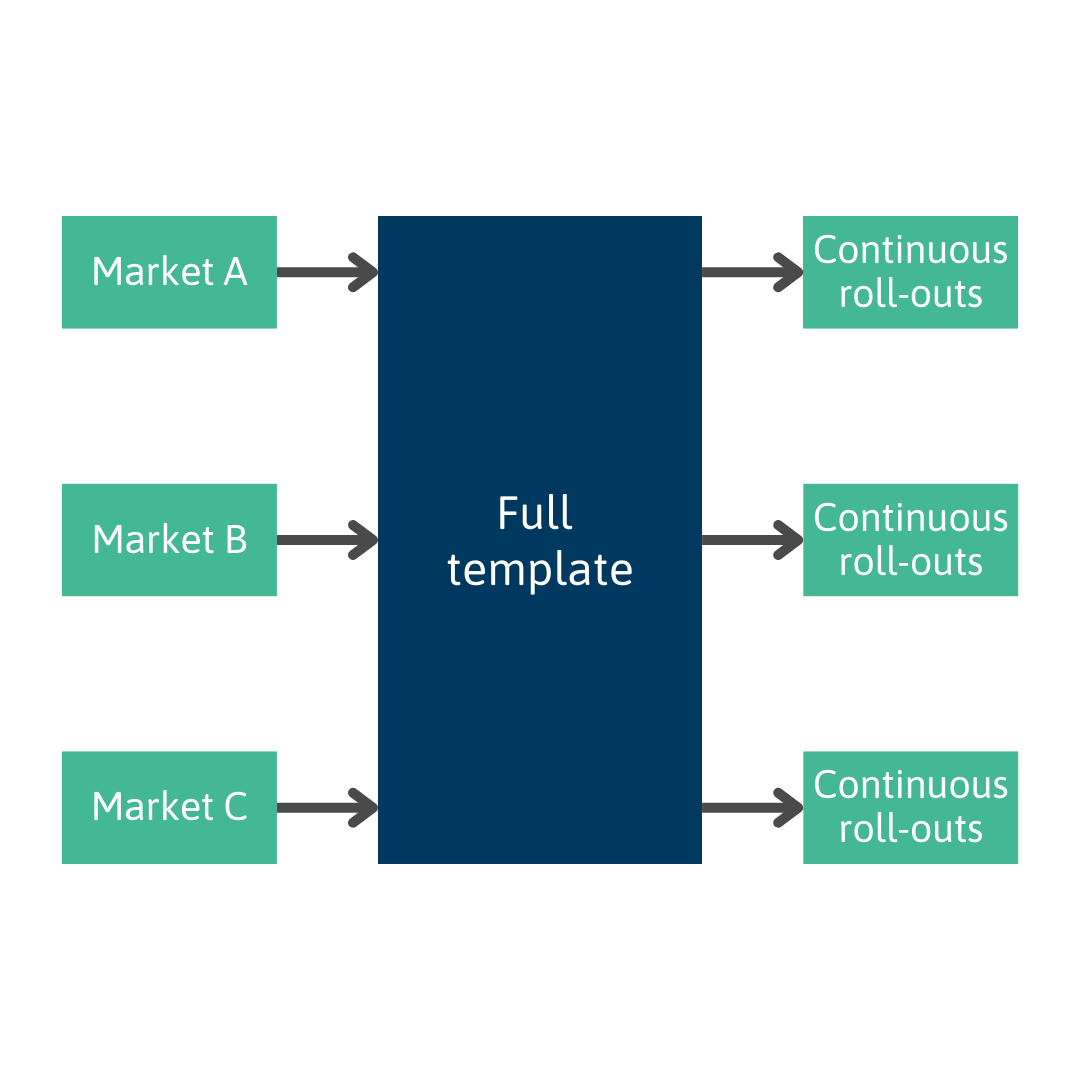Impacts on global template strategy per organization type
Leveraging Global Templates to Reduce Risks and Costs in Multinational Digital Transformation Projects

Global transformation projects are no easy feats. As supply chains become more fragile, customer expectations rise, and AI innovations accelerate, it’s more important than ever that multinational organizations become agile, data-driven, and harmonized. At the same time, multi-country digital transformation projects demand expert guidance and pose unique challenges.
As part of HSO’s commitment to being the ultimate Microsoft partner across the globe, HSO International was formed. HSO International serves as the specialized global implementation arm, dedicated to serving the specific needs of multinational organizations. A central element of our customers’ success is our global template approach.
Continue reading to understand why a global template is essential for international rollouts, how different organizational structures impact rollout strategy, and the three main types of global template strategies we suggest to our clients.
What is a global template?
A global template is a standardized framework that multinational companies use to implement consistent processes and systems across different regions.

By leveraging a global template, companies can achieve uniformity in their operations, streamline data management, and enhance overall efficiency. HSO's global template approach offers numerous benefits, including reduced implementation time, cost savings, and improved data accuracy.
Next to this standardized approach, HSO International balances the unique needs of each of our customers. A global template must provide standardization while also allowing for the appropriate level of flexibility. Local regulatory requirements are always a factor in global rollouts. Additionally, organizational structure will dictate how many unique functionalities the global template accommodates. More on this later.


Why leverage a global template?
Leveraging a global template offers numerous advantages for multinational organizations, which can impact at different stages of the transformation project.
One of the primary benefits is the ability to achieve centralized business insights, which enables a unified set of global reporting across the enterprise at a group level. This centralized approach also allows leaders to understand the differences between various entities within the organization. Standardized processes, definitions, and calculations are prerequisites to unlocking this.
Another significant advantage of using a global template is the increased efficiency of implementation. Once a template is defined, it can be easily rolled out to other entities without the need to completely reinvent the wheel. This streamlined approach saves time and resources, allowing for a quicker and more efficient implementation process.
After the implementation, the centralized approach leads to efficiencies in cost, time, and resources for support across the globe. The new system can be supported globally, leveraging economies of scale, rather than relying on a collection of local resources to support local deviations from the template. This global support model ensures that the system remains consistent and efficient, reducing the overall costs and complexities associated with maintaining multiple localized systems.
How organizational structures impact IT strategy
As mentioned earlier, well-designed global templates account for some degree of flexibility between business units. International business is inherently complex, and different business cultures and structures support different levels of standardization of the template.


Based on our experience, the degree to which a global template can be leveraged depend on two dimensions of the organization: global business diversity and business unit autonomy, visualized in the visual on the left.
- Global business diversity: Degree to which your business units offer similar goods and/or services in similar models.
- Business unit autonomy: Degree to which the business units are globally centralized (top-down) and extent of business unit autonomy (bottom-up)
DiverseCorp
Globally diverse & centralized corporation
The diversity across the business units means that more localizations will be required. However, the centralized mandate structure enables global leadership to enforce the harmonization of processes, reporting, etcetera that still enable a partial template rollout.
DiverseAuto
Globally diverse & autonomous business units
More flexible templating strategies are required here. The wide variety of processes between business units and the high degree of autonomy within business units means a larger number of unique functionalities will be required. Therefore, a global template poses both high risks and high costs.
UniCorp
Globally homogenous & centralized corporation
A global template usually works well here, thanks to the similarities across the business and centralized governance structure. Typically, a robust template can be built and easily be rolled out into other countries. This leads to efficient implementation of a global template, with the addition of small localizations for regulatory or other reasons.
UniAuto
Globally homogenous & autonomous business units
A global template can capture similarities across the business units, but the lack of centralization means that individual business units will be less willing to adapt their processes to fit with a global template, increasing the need for localizations. Watch out – the importance of centralized structure to a global template is often underestimated, at great costs!

Global rollout strategies: Choose a template implementation approach carefully
To account for the different types of organizations described above, HSO International proposes a variety of global template implementation strategies. Selecting the right global rollout strategy is essential for minimizing risks. Broadly speaking, most template implementation strategies fall into one of three main types.
1. Full Template Build
This strategy is ideal for the “UniCorps” of the world, which are globally organized companies with similar business processes across regions. The full template build ensures uniformity and consistency in operations. Usually, requirements and definitions can be gathered at the beginning of a project and then built into a template. In this strategy, each rollout starts with trying to get as much of the business as possible on the template, then adding localizations only as strictly necessary (e.g. for local regulatory reasons).

2. Variations Template

We most often recommend this strategy to the “DiverseAuto” type of organizations. With diverse businesses and less centralized governance, template variations are necessary for these businesses. In this strategy, a variety of templates are created to coexist next to each other. This strategy allows for unique functionalities while maintaining the core principles of the global template.
3. Evolving Template
Finally, the cascading template best meets the needs of the “DiverseCorp” and “UniAuto” styles of organizations. These organizations have either diversity in their businesses or a lack of a true global mandate. In both instances, planning for adjustments and adaptations is the key for success.
By starting with a minimum viable product (MVP) at the start, space is left for future rollouts to add functionality as required. These additional functionalities go into a library, and as the global rollouts continue, the library expands as additional functionalities are added. This enables a balance of efficiency, as functionalities can be used across business units from the library, and adaptability, as there is always the potential to add new functionalities.

The Bottom Line
In conclusion, leveraging a global template is a strategic approach that offers numerous benefits for multinational organizations. Our decades of experience with global rollouts have taught us that by carefully evaluating your organization’s structure and choosing an appropriate global template implementation strategy, business leaders can save time, money, and mitigate risks of the global implementation itself.
As businesses continue to navigate the complexities of global operations, adopting a global template can be a key driver of success, enabling organizations to remain agile, data-driven, and harmonized in an ever-evolving market landscape

Ready to meet the unique demands of your global transformation project?
Ready to transform your multinational operations with a well-strategized global template? Contact us today to learn how our tailored strategies can help your organization achieve centralized insights, increased efficiency, and significant cost savings. Let us guide you through the complexities of global rollouts and deliver results. Reach out now and take the first step towards a global transformation project that will truly meet the unique needs of your multinational organization.
Discover more about our true global practice

